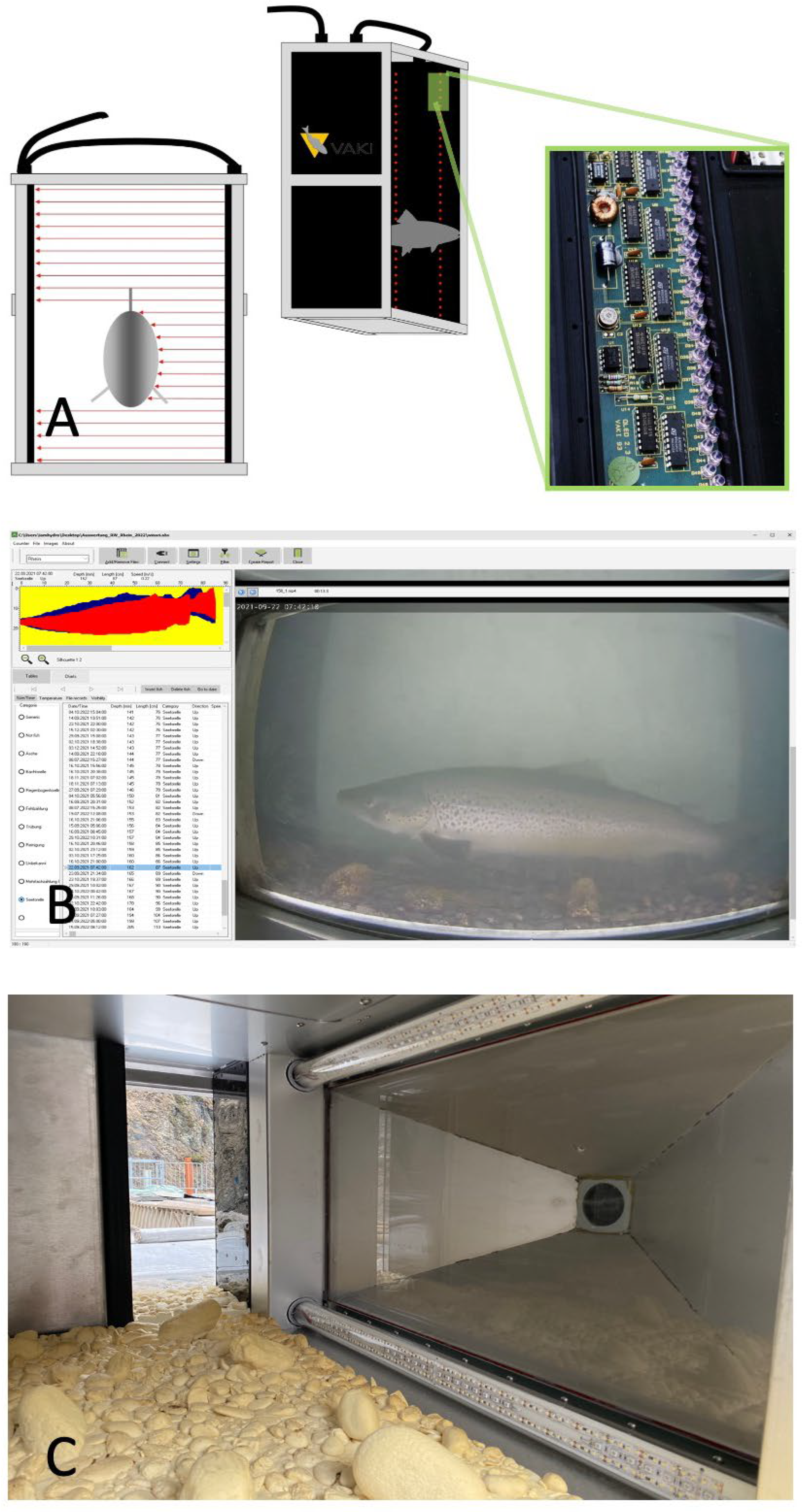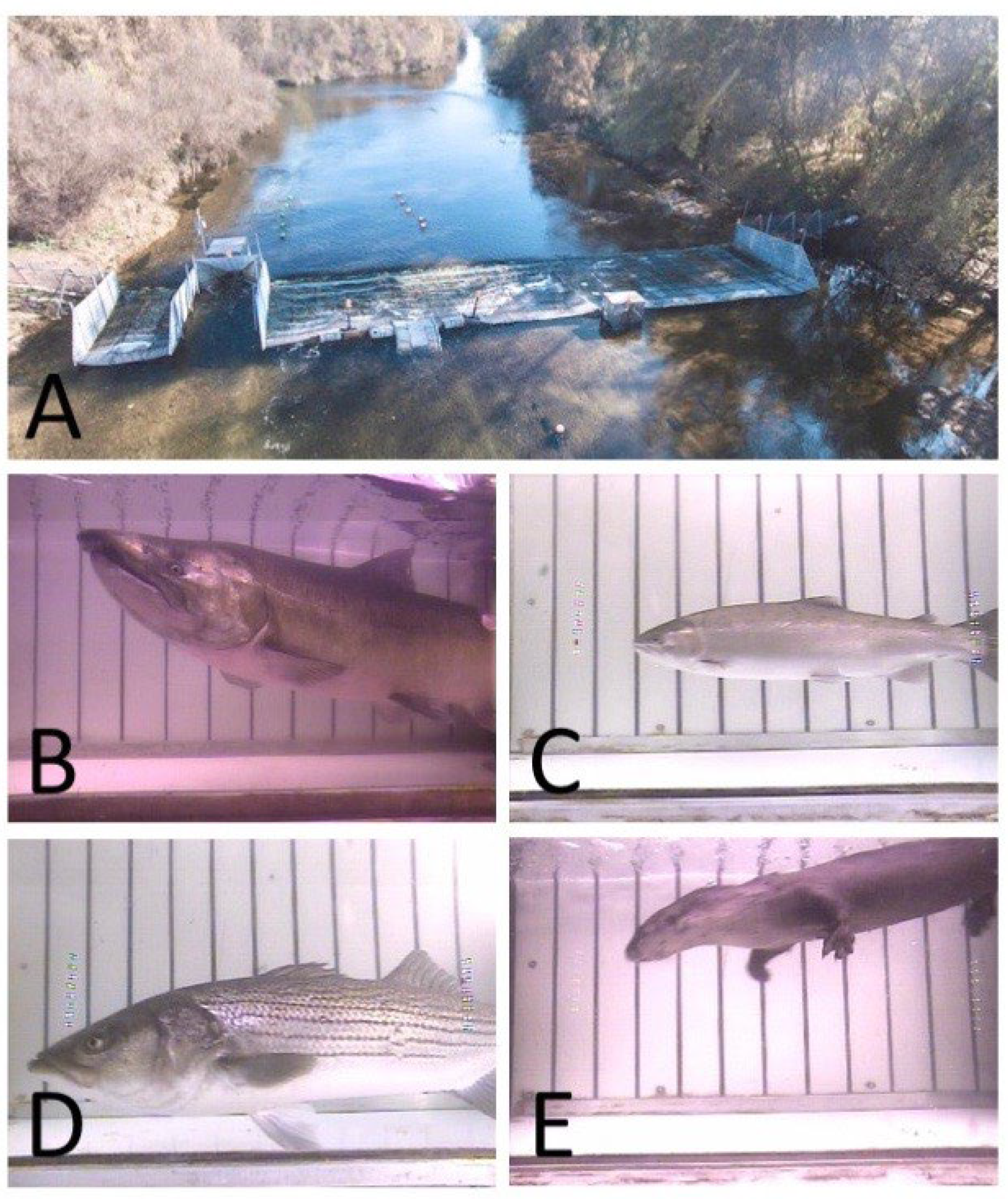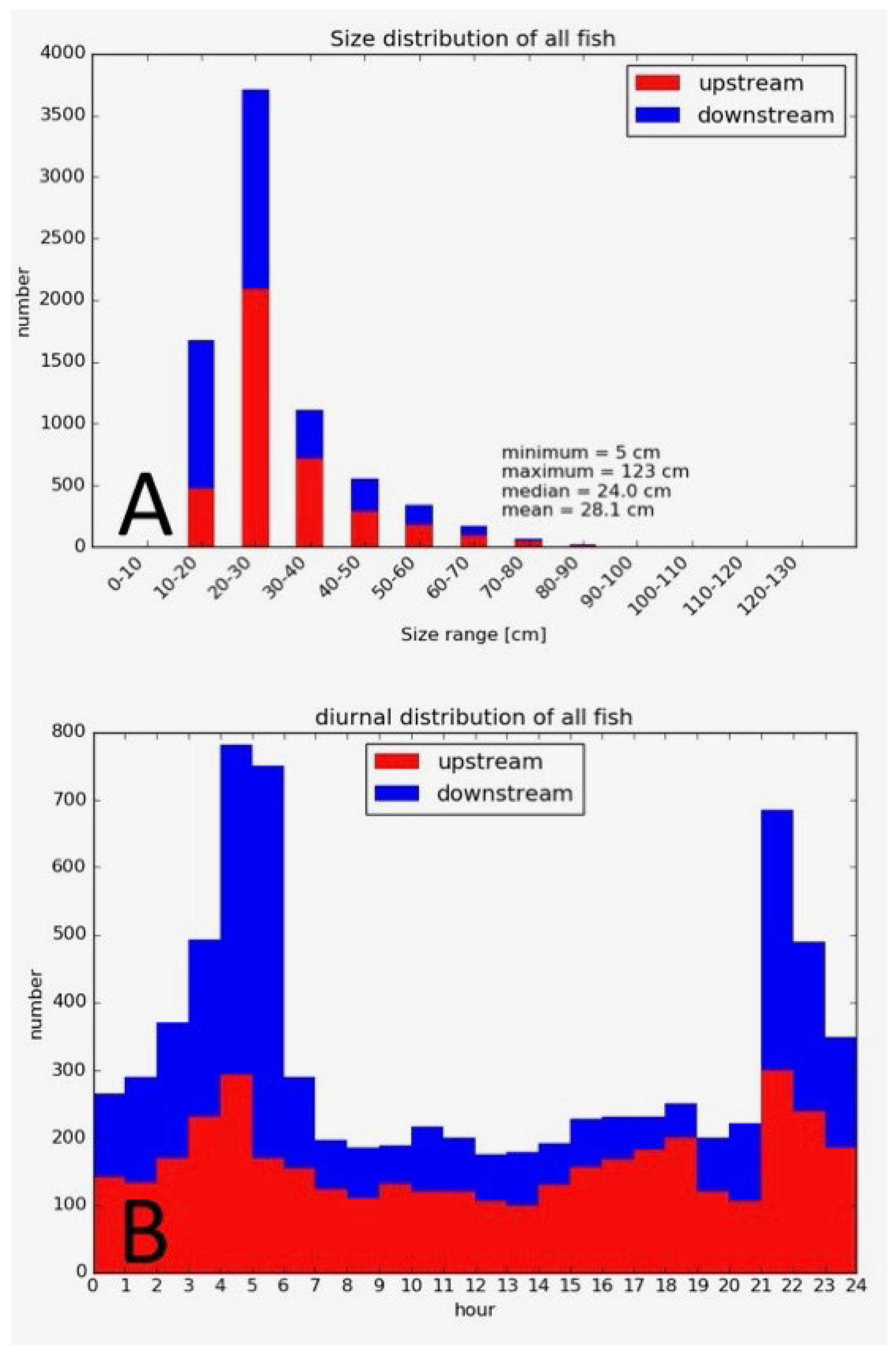Monitoring of Fish Migration in Fishways and Rivers—The Infrared Fish Counter “Riverwatcher” as a Suitable Tool for Long-Term Monitoring
Abstract
:1. Introduction
2. System Features and Its Application
3. In Practice: Case Studies Showcasing the Riverwatcher’s Application in Fish Monitoring
3.1. Monitoring Passage at Fishways
3.2. Monitoring Passage at Weirs
3.3. Selected Datasets
3.3.1. Monitoring of Vertical-Slot Fishways
3.3.2. Monitoring of Nature-like Fishway
3.3.3. Monitoring of Open Channels
4. Discussion
- Missed counts can occur if the device malfunctions or if turbidity causes the sensors to fail. If multiple fish pass the scanner simultaneously and only one is counted or if fish pass the device too quickly to trip the sensors, then this will result in missed counts.
- False counts occur when objects passing through the scanner (e.g., beavers or debris) and silhouettes are mistaken for the target species.
- Mixed counts can happen if a fish species other than the target species is misidentified and recorded as a species of interest.
- By-passed counts will occur if fish are not properly guided through the device due to improper weir installation or if the swim corridor is not constricted enough to trip the device sensors.
- Double counts can happen if an individual is counted moving upstream and then drops below the device without being counted (e.g., it moves downstream through the camera chamber at the same time as another individual is moving upstream) and is counted again as it swims upstream past the detector a second time.
- Observer errors can occur when there is variation within and among observers in count verification and species identification. This type of error can also occur if data files become corrupted or lost.
Author Contributions
Funding
Data Availability Statement
Conflicts of Interest
References
- DWA M-509 Deutsche Vereinigung für Wasserwirschaft, A.u. Fischaufstiegsanlagen und Fisch-Passierbare Bauwerke—Gestaltung, Bemessung, Qualitätssicherung. 2014. Available online: https://shop.dwa.de/en/DWA-M-509-Fischaufstiegsanlagen-5-2014/M-509-BUNDLE-14 (accessed on 1 August 2023).
- Hering, D.; Borja, A.; Carstensen, J.; Carvalho, L.; Elliott, M.; Feld, C.K.; Heiskanen, A.-S.; Johnson, R.K.; Moe, J.; Pont, D.; et al. The European Water Framework Directive at the age of 10: A critical review of the achievements with recommendations for the future. Sci. Total Environ. 2010, 408, 4007–4019. [Google Scholar] [CrossRef] [PubMed]
- Schletterer, M.; Reindl, R.; Thonhauser, T. Options for Re-Establishing River Continuity, with an Emphasis on the Special Solution “Fish Lift”: Examples from Austria. Rev. Eletrôn. Gestão Tecnol. Ambient. (GESTA) 2016, R4/1, 109–128. Available online: https://portalseer.ufba.br/index.php/gesta (accessed on 1 August 2023). [CrossRef]
- Haas, C.; Thumser, P.; Mockenhaupt, B.; Schletterer, M. Das System VAKI-Riverwatcher als Möglichkeit für ein Langzeitmonitoring von Fisch-Migration in Fischwanderhilfen. Wasserwirtschaft 2018, 9, 41–48. [Google Scholar] [CrossRef]
- EN 17233:2021; Water Quality. Guidance for Assessing the Efficiency and Related Metrics of Fish Passage Solutions Using Telemetry. The European Committee for Standardization CEN: Brussels, Belgium, 2021.
- I Am Hydro, G. I Am Hydro GmbH. Von. 2021. Available online: https://iamhydro.com/downloads/i-am-hydro_flyer_hydrocam_2021_en.pdf (accessed on 1 August 2023).
- Mader, H.; Käfer, S. FishCam & FishNet—Fischökologisches Monitoring 4.0; Österreichische Wasser-und Abfallwirtschaft: Vienna, Austria, 2020; Volume 72, pp. 129–141. [Google Scholar]
- Li, D.; Hao, Y.; Duan, Y. Nonintrusive methods for biomass estimation in aquaculture with emphasis on fish: A review. Rev. Aquac. 2019, 12, 1390–1411. [Google Scholar] [CrossRef]
- MSD Animal Health. VAKI Riverwatcher. 2023. Available online: https://www.riverwatcher.is/ (accessed on 1 August 2023).
- de Leaniz, C.G.; Forman, D.W.; Davies, S.; Thomson, A. Non-intrusive monitoring of otters (Lutra lutra) using infrared technology. J. Zool. 2006, 270, 577–584. [Google Scholar] [CrossRef]
- Haas, C.; Thumser, P.; Völker, F. Technisches Monitoring mit einem Infrarot Fischzähler (VAKI Riverwatcher) am Lachsbach, Sachsen. Wasserwirtschaft 2014, 7/8, 97. [Google Scholar]
- Thumser, P.; Haas, C.; Schletterer, M. Technical Monitoring of Fishways: Long Term Monitoring of Fish Movement with the VAKI Riverwatcher along River Inn. Deutsche Gesellschaft für Limnologie (DGL), Erweiterte Zusammenfassungen der Jahrestagung 2016, Hardegsen, 191–195 (Vienna). 2017. Available online: https://www.dgl-ev.de/cms/upload/dokumente/Publikationen/Erweiterte_Zusammenfassungen_Wien_2016.pdf (accessed on 26 September 2022).
- Santos, J.M.; Pinheiro, P.J.; Ferreira, M.T.; Bochechas, J. Monitoring fish passes using infrared beaming: A case study in an Iberian river. J. Appl. Ichthyol. 2008, 24, 26–30. [Google Scholar] [CrossRef]
- Shardlow, T.F.; Hyatt, K.D. Assessment of the counting accuracy of the Vaki infrared counter on chum salmon. North Am. J. Fish. Manag. 2004, 24, 249–252. [Google Scholar] [CrossRef]
- Cuthbert, R.; Fuller, A.; Snider, S. Fall/Winter Migration Monitoring at the Tuolumne River Weir 2009/10 Annual Report. Prepared for: Turlock Irrigation District Modesto Irrigation District. 2010. 16p. Available online: https://tuolumnerivertac.com/Documents/2009TuolWeirReportFinal.pdf (accessed on 1 August 2023).
- Valley Water. 2019 Guadalupe River Watershed Fisheries Monitoring. 2020. 154p.. Available online: https://www.valleywater.org/sites/default/files/2019%20Guadalupe%20Watershed%20Fisheries%20Reports%20Compiled.pdf (accessed on 1 August 2023).
- Pilger, T.J.; Jonagan, E.; Peterson, M.L.; Guignard, J.; Demko, D.; Fuller, A. Estimates of Fall-run Chinook Salmon Escapement in Two San Joaquin River Tributaries from 2 Device-based and Survey-based Methods. bioRxiv 2023, preprint. [Google Scholar] [CrossRef]
- Baumgartner, L.; Bettanin, M.; Mcpherson, J.; Jones, M.J.; Zampatti, B.; Beyer, K. Assessment of an Infrared Fish Counter (Vaki Riverwatcher) to Quantify Fish Migrations in the Murray–Darling Basin; Industry & Investment NSW—Fisheries Final Report Series No. 116; NSW Department of Primary Industries: Albury, Australia, 2010; p. 47. [Google Scholar]
- Baumgartner, L.J.; Bettanin, M.; McPherson, J.; Jones, M.; Zampatti, B.; Beyer, K. Influence of turbidity and passage rate on the efficiency of an infrared counter to enumerate and measure riverine fish. J. Appl. Ichthyol. 2012, 28, 531–536. [Google Scholar] [CrossRef]
- Jones, M.J.; O’Connor, J.P. Monitoring the performance of fishways and fish passage works. In Arthur Rylah Institute for Environmental Research; Technical Report Series No. 257; Department of Environment, Land Water and Planning: Heidelberg, VIC, Australia, 2017; p. 74. [Google Scholar]
- Schletterer, M.; Senn, G.; Menghin, M.; Hubmann, M.; Schwarzenberger, R.; Haas, C.; Thumser, P.; Asgeirsson, M.T. Technisches Fischmonitoring: Installation des ersten RiverWatcher Fischzählers in Österreich. Wasserwirtschaft 2015, 7/8, 103–108. [Google Scholar] [CrossRef]
- Ontario Ministry of Natural Resources and Forestry. Lake Ontario Fish Communities and Fisheries: 2018 Annual Report of the Lake Ontario Management Unit; Ontario Ministry of Natural Resources and Forestry: Picton, ON, Canada, 2019; p. 230. ISSN1 1201-8449. Available online: http://www.glfc.org/loc_mgmt_unit/LOA%2019.01.pdf (accessed on 1 August 2023)ISSN2 1201-8449.
- Prchalová, M.; Slavík, O.; Bartoš, L. Patterns of cyprinid migration through a fishway in relation to light, water temperature and fish circling behaviour. Int. J. River Basin Manag. 2004, 4, 213–218. [Google Scholar] [CrossRef]
- Orell, P.; Erkinaro, J.; Kiljunen, M.; Torniainen, J.; Sutela, T.; Jaukkuri, M.; Mäki-Petäys, A. Short sea migration and precocious maturation in reared Atlantic salmon post-smolts in the northern Baltic Sea. ICES J. Mar. Sci. 2018, 75, 1063–1070. [Google Scholar] [CrossRef]
- Fédération du Pas de Calais Pour la Pêche et la Protection du Milieu Aquatique. Available online: http://www.peche62.fr/station-de-videocomptage-a-mourlinghen/ (accessed on 1 August 2023).
- MFRI. Risk of Intrusion of Farmed Atlantic Salmon into Icelandic Salmon Rivers: MFRI Assessment Reports (Report No. 2020); Marine & Freshwater Research Institute: Hafnarfjörður, Iceland, 2020; p. 57. Available online: https://www.hafogvatn.is/static/extras/images/taekni-Ah%C3%A6ttumat_ens1199280.pdf/ (accessed on 1 August 2023).
- Farrell, M.M.; McGinnity, P.; Poole, W.R.; Rogan, G.; O’Maoileidigh, N.; Bond, N.; Kristjansson, H. A comparison of salmonid census results obtained by the Vaki Riverwatcher and upstream trap on the Burrishoole River system, Western Ireland. May 2017. Annu. Rep. Salmon Res. Agency Irel. 1998, 43, 57–59. [Google Scholar] [CrossRef]
- Skaala; Johnsen, G.H.; Lo, H.; Borgstrøm, R.; Wennevik, V.; Hansen, M.M.; Merz, J.E.; Glover, K.A.; Barlaup, B.T. A conservation plan for Atlantic salmon (Salmo salar) and anadromous brown trout (Salmo trutta) in a region with intensive industrial use of aquatic habitats, the Hardangerfjord, western Norway. Mar. Biol. Res. 2014, 10, 308–322. [Google Scholar] [CrossRef]
- Holter, T.H.; Myrvold, K.M.; Pulg, U.; Museth, J. Evaluating a fishway reconstruction amidst fluctuating abundances. River Res. Appl. 2020, 36, 1748–1753. [Google Scholar] [CrossRef]
- Dębowski, P.; Bernaś, R.; Radtke, G.; Święcki, W. Assessment of the effectiveness of fish passage through the vertical-slot fishway at the main dam on the longest Baltic River. Fish. Aquat. Life 2022, 30, 175–183. [Google Scholar] [CrossRef]
- García-Vega, A.; Sanz-Ronda, F.J.; Fuentes-Pérez, J.F. Seasonal and daily upstream movements of brown trout Salmo trutta in an Iberian regulated river. Knowl. Manag. Aquat. Ecosyst. 2017, 418, 9. [Google Scholar] [CrossRef]
- Haas, C.; Thumser, P. Riverwatcher Fischzähler am KW Reichenau am Alpenrhein Technischer Bericht und Auswertung der Fischauf-und Abstiege. Technical report. 2021. 66p.. Available online: https://www.gr.ch/DE/institutionen/verwaltung/diem/ajf/fischerei/dokumentation-projekte/Documents/RW_Reichenau_Bericht.pdf (accessed on 1 August 2023).
- HELCOM. Salmon and Sea Trout Populations and Rivers in the Baltic Sea—HELCOM assessment of salmon (Salmo salar) and sea trout (Salmo trutta) populations and habitats in rivers flowing to the Baltic Sea. Balt. Sea Environ. Proc. 2011, 126, 82. Available online: https://www.helcom.fi/wp-content/uploads/2019/08/BSEP126A.pdf (accessed on 1 August 2023).
- ICES. Baltic Salmon and Trout Assessment Working Group (WGBAST). ICES Sci. Rep. 2021, 3, 331. [Google Scholar] [CrossRef]
- Eatherley, D.M.R.; Thorley, J.L.; Stephen, A.B.; Simpson, I.; MacLean, J.C.; Youngson, A.F. Trends in Atlantic salmon: The role of automatic fish counter data in their recording. Scottish Natural Heritage Commissioned Report No. 100 (ROAME No. F01NB02). 2005. Available online: https://www.researchgate.net/publication/282251586_Trends_in_Atlantic_Salmon_the_role_of_automatic_fish_counter_data_in_their_recording (accessed on 1 August 2023).
- Chariskos, D. Analysis of the Run of Two Salmonid Species, by Using Data from a Vaki Riverwatcher Counter, at the River Dullan in 2007; University of Aberdeen: Aberdeen, Scotland, 2007; p. 54. [Google Scholar]
- Fisheries Management Scotland. 2019 Annual Review, 44. p. 2019. Available online: https://fms.scot/wp-content/uploads/2019/03/FMS-2019.pdf (accessed on 1 August 2023).
- Cowan, W.R.; Rankin, D.E.; Gard, M. Evaluation of Central Valley Spring-Run Chinook Salmon Passage Through Lower Butte Creek Using Hydraulic Modelling Techniques. River Res. Appl. 2016, 33, 328–340. [Google Scholar] [CrossRef]
- Peterson, M.L.; Fuller, A.N.; Demko, D. Environmental factors associated with the upstream migratory activity of fall-run Chinook salmon in a regulated river. North Am. J. Fish. Manag. 2017, 37, 78–93. [Google Scholar] [CrossRef]
- Mockenhaupt, B.; Scholten, M. Large automatic fish counter—An option to register migrating fishes in a technical fishway quantitatively? In Proceedings of the 9th International Symposium on Ecohydraulics 2012, Vienna, Austria, 17–21 September 2012; 2012. [Google Scholar]
- Haas, C.; Thumser, P.; Mannfeld, M. Technischer Bericht und Auswertung der Fischauf-und abstiege Umgehungsgerinne Zugwiesen, Neckar. Technical report. 65p. 2017.
- Cuthbert, R. “Going Beyond Visible Light; Monitoring Adult Fish Passage in Turbid Conditions with Technological Advancements and Sense of Public Outreach”. International Conference on Engineering and Ecohydrology for Fish Passage. 12. 2017. Available online: https://scholarworks.umass.edu/fishpassage_conference/2017/June21/12 (accessed on 1 August 2023).
- Kiffney, P.M.; Lisi, P.J.; Liermann, M.; Naman, S.M.; Anderson, J.H.; Bond, M.H.; Pess, G.R.; Koehler, M.E.; Buhle, E.R.; Buehrens, T.W.; et al. Colonization of a temperate river by mobile fish following habitat reconnection. Ecosphere 2023, 14, e4336. [Google Scholar] [CrossRef]
- Bergman, J.M.; Nielson, R.M.; Low, A. Central Valley in-River Chinook Salmon Escapement Monitoring Plan; Fisheries Branch Administrative Report Number: 2012-1; California Department of Fish and Game: Sacramento, CA, USA, 2012. Available online: https://nrm.dfg.ca.gov/FileHandler.ashx?DocumentID=42213&inline=1 (accessed on 1 March 2018).
- Groß, J. Ökologische Durchgängigkeit der Mosel—Neubau einer Fischwechselanlage mit Monitoringstation sowie eines Besucher-Informationszentrums “Mosellum” an der Moselstaustufe in Koblenz. Korresp. Wasserwirtsch. 2014, 7, 107–112. [Google Scholar]
- Orell, P.; Jaukkuri, M.; Huusko, R.; Mäki-Petäys, A. VAKI-Kalalaskurin Luotettavuus ja Hyödyntämismahdollisuudet Kalateiden Seurannassa; Riista—Ja kalatalouden tutkimuslaitos: Helsinki, Finland, 2012; p. 27. [Google Scholar]
- Haberbosch, R. Umgehungsgerinne und Neckarseitenarm in Ludwigsburg—Gewann Zugwiesen Monitoring 2013–2014. Internal report; 2015. [Google Scholar]
- Adam, B.; Lehmann, B. Ethohydraulik: Grundlagen, Methoden und Erkenntnisse; Springer: Berlin/Heidelberg, Germany, 2011. [Google Scholar]
- Schmidt, M.B.; Tuhtan, J.A.; Schletterer, M. Hydroacoustic and Pressure Turbulence Analysis for the Assessment of Fish Presence and Behavior Upstream of a Vertical Trash Rack at a Run-of-River Hydropower Plant. Appl. Sci. 2018, 8, 1723. [Google Scholar] [CrossRef]
- Soom, J.; Pattanaik, V.; Leier, M.; Tuhtan, J.A. Environmentally adaptive fish or no-fish classification for river video fish counters using high-performance desktop and embedded hardware. Ecol. Informatics 2022, 72, 101817. [Google Scholar] [CrossRef]
- Thorstad, E.B.; Økland, F.; Aarestrup, K.; Heggberget, T.G. Factors affecting the within-river spawning migration of Atlantic salmon, with emphasis on human impacts. Rev. Fish Biol. Fish. 2008, 18, 345–371. [Google Scholar] [CrossRef]
- Lucas, M.C.; Baras, E. Migration of Freshwater Fishes; Blackwell Science: Hoboken, NJ, USA, 2001; ISBN 0-632-05754-8. [Google Scholar]




| Location | Target Species | Version | Installation (Since) | Type of Fishway | Scanner Width | Scanner Height | Reference |
|---|---|---|---|---|---|---|---|
| Lachsbach River, Germany | Atlantic salmon (Salmo salar) | Scanner | 2006 | Vertical slot | 40 cm | single | [11] |
| Moselle River, Germany | Species assembly 30+ | Scanner, camera, and motion detection | 2011 | Vertical slot | 45 cm | Double | [40] |
| Aare River, Switzerland | Salmonids, including brown trout (Salmo trutta f. fario), grayling (Thymallus thymallus), lake trout (Salmo trutta lacustris) | Scanner and camera | 2015 | Vertical slot | 40 cm | Single | [n/a] |
| Neckar River, Germany | Species assembly 30+ | Scanner and camera | 2016 | Nature-like fishway | 40 cm | Single | [41] |
| Inn River, Austria | Salmonids, including brown trout (Salmo trutta f. fario), grayling (Thymallus thymallus), and Huchen (Hucho hucho) | Scanner and camera | 2015 | Vertical slot | 35 cm | Single | [22] |
| Pitze River, Austria | Brown trout (Salmo trutta f. fario) | Scanner | 2014 | Vertical slot | 20 cm | Single | [4,21] |
| Rhine River, Switzerland | Lake trout (Salmo trutta lacustris) | Scanner and camera | 2017 | Vertical slot | 40 cm | Double | [32] |
| Stanislaus River, California | Chinook salmon (Oncorhynchus tshawytscha) and steelhead (Oncorhynchus mykiss) | Scanner and camera | 2004 | Resistance board weir; in-river | 40 cm | Single | [39] |
| Tuolumne River, California | Chinook salmon (Oncorhynchus tshawytscha) and steelhead (Oncorhynchus mykiss) | Scanner and camera | 2009 | Resistance board weir; in-river | 40 cm | Single | [15] |
| Salinas River, California | Steelhead (Oncorhynchus mykiss) | Scanner and camera | 2010 | Resistance board weir; in-river | 30–40 cm | Single | [42] |
| Cedar River, Washington | Salmonids, including Chinook salmon (Oncorhynchus tshawytscha), coho salmon (Oncorhynchus kisutch), and sockeye salmon (Oncorhynchus nerka) | Scanner and camera | 2014 | Pool and weir fishway | 40 cm | Single | [43] |
| Mahagony Creek, Nevada | Cutthroat trout (Oncorhynchus clarki) | Scanner | 2011 | Rigid weir; in-river | 40 cm | Single | [n/a] |
| Truckee River, Nevada | Cutthroat trout (Oncorhynchus clarki henshawi), Cui-ui (Chasmistes cujus) | Scanner | 2011 | Nature-like fishway | 40 cm | Single | [n/a] |
| Credit River, Ontario | Steelhead (Oncorhynchus mykiss) | Scanner and camera | 2016 | Pool and weir fishway | 40 cm | Single | [n/a] |
Disclaimer/Publisher’s Note: The statements, opinions and data contained in all publications are solely those of the individual author(s) and contributor(s) and not of MDPI and/or the editor(s). MDPI and/or the editor(s) disclaim responsibility for any injury to people or property resulting from any ideas, methods, instructions or products referred to in the content. |
© 2024 by the authors. Licensee MDPI, Basel, Switzerland. This article is an open access article distributed under the terms and conditions of the Creative Commons Attribution (CC BY) license (https://creativecommons.org/licenses/by/4.0/).
Share and Cite
Haas, C.; Thumser, P.K.; Hellmair, M.; Pilger, T.J.; Schletterer, M. Monitoring of Fish Migration in Fishways and Rivers—The Infrared Fish Counter “Riverwatcher” as a Suitable Tool for Long-Term Monitoring. Water 2024, 16, 477. https://doi.org/10.3390/w16030477
Haas C, Thumser PK, Hellmair M, Pilger TJ, Schletterer M. Monitoring of Fish Migration in Fishways and Rivers—The Infrared Fish Counter “Riverwatcher” as a Suitable Tool for Long-Term Monitoring. Water. 2024; 16(3):477. https://doi.org/10.3390/w16030477
Chicago/Turabian StyleHaas, Christian, Philipp Klaus Thumser, Michael Hellmair, Tyler J. Pilger, and Martin Schletterer. 2024. "Monitoring of Fish Migration in Fishways and Rivers—The Infrared Fish Counter “Riverwatcher” as a Suitable Tool for Long-Term Monitoring" Water 16, no. 3: 477. https://doi.org/10.3390/w16030477
APA StyleHaas, C., Thumser, P. K., Hellmair, M., Pilger, T. J., & Schletterer, M. (2024). Monitoring of Fish Migration in Fishways and Rivers—The Infrared Fish Counter “Riverwatcher” as a Suitable Tool for Long-Term Monitoring. Water, 16(3), 477. https://doi.org/10.3390/w16030477







